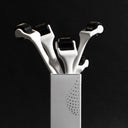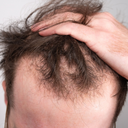Seeing more hair on your pillow or noticing thinning hair in the mirror can be scary. This is because hair loss can change how you look and hurt your self-esteem [1]. Studies show that 40% of women with hair loss have marriage problems, and 63% have job issues [2]. Both men and women with hair loss also feel older and worry about how they look. Unfortunately, half the world's population experiences hair loss [3].
The good news is, understanding how hormones affect hair can help slow down hair loss. In this guide, we’ll look at how hormones affect your hair. We'll also share tips and treatments to help you keep your hair healthy.
Table of content
Hormones and the Hair Growth Cycle
To see how hormones affect your hair, we need to understand the hair growth cycle.
Each hair follicle goes through three stages [4]:
- Anagen Phase: This is the growth phase and lasts 1 to 6 years. About 90-95% of your hair is in this phase at any time.
- Catagen Phase: This is a short phase where the hair stops growing and gets ready to shed.
- Telogen Phase: This is the resting phase, lasting 2 to 3 months. The old hair falls out, and new hair starts to grow.
Disruption of this cycle leads to hair loss. Healthy hairs turn into thin, weak hairs (vellus hairs) that fall out.
Specific hormones can disrupt the hair growth cycle. These include:
- Androgens (male sex hormones like testosterone)
- Female hormones (like oestrogen and progesterone)
- Thyroid hormones
- Cortisol
Let's look at each of these hormones in more detail.
How Do Androgens — Male Sex Hormones like Testosterone — Affect Hair Health?

Androgens play a huge role in hair health [5]. Testosterone (an androgen) turns into a stronger hormone called DHT (dihydrotestosterone). DHT can shrink hair follicles, making hair thinner and weaker. In other words, higher levels of testosterone can mean more DHT, increasing the risk of hair loss.
Also, some people are more sensitive to DHT due to their genetics. This genetic sensitivity can lead to pattern baldness, which is very common in men and can also happen in women.
In men, hair loss usually starts at the temples and crown. This leads to a receding hairline and bald spots. In women, hair loss tends to be more diffuse thinning across the scalp and a widening parting.
How Do Female Hormones Affect Hair Health?
When female hormones (oestrogen and progesterone) are high, they keep hair growing longer. As a result, hair becomes thicker and healthier. But when these hormone levels drop, hair can start to shed more causing noticeable hair loss and thinning.
- How Does Pregnancy Change Your Hair?
During pregnancy, levels of oestrogen and progesterone rise, making hair thicker. But after giving birth, these hormone levels drop. This sudden change causes many hair follicles to enter the shedding phase prematurely, resulting in noticeable hair loss. This condition, called postpartum telogen effluvium, affects over 90% of women after childbirth [6].
- What Happens to Your Hair During Menopause?
50% of women will experience hair loss (and thinning) during menopause [7].
During menopause, oestrogen and progesterone levels decline. This drop in female hormones makes androgens more active, which can lead to hair thinning.
Hormonal fluctuations and ageing also impact hair follicles. This, too, causes thinning, loss of volume, and changes in hair texture.
- How Does PCOS Impact Hair Health?
Polycystic ovary syndrome (PCOS) is a common hormone problem that affects about 1 in 10 women. It is the result of high levels of androgens (male sex hormones) in the female body.
These high androgen levels can lead to scalp hair loss and unwanted facial hair. Many women with PCOS also experience thinning hair on their heads. This condition is called androgenetic alopecia (AGA). Studies show that 22% of women with PCOS experience AGA [8].
How Do Thyroid Hormones Impact Your Hair?
Thyroid hormones control how cells grow, change, and use energy. The skin, including hair follicles, is a major target for these hormones.
Thus, when thyroid hormones are not at the right levels, it can cause hair problems [9]. In other words, too much thyroid hormone (hyperthyroidism) can lead to hair loss. Likewise, too little thyroid hormone (hypothyroidism) can also cause hair loss.
The Stress - Cortisol Connection: Does Cortisol Make Your Hair Fall Out?
Cortisol, known as the stress hormone, is central to your body's response to stress. When you're stressed, your cortisol levels rise. This can mess up your hair's growth cycle and push more hair into the shedding phase.
Thus, high cortisol levels can cause a condition called telogen effluvium. This is when stress makes your hair fall out more than usual. A study found that 71.3% of people reported hair loss due to stress [10], affecting women more than men. Stress from personal problems and money issues also showed a strong link to hair loss.
As your leading source for hair health information over the past 4 years, we never compromise on accuracy. When it comes to your health, you deserve information you can truly rely on - and earning your trust is our top priority.
Here's how Scandinavian Biolabs ensures every piece of content meets the highest standards of accuracy and integrity:
- Credentialed Experts: Our reviewers are actively practicing doctors and medical researchers
- Stringent Reviews: Content undergoes rigorous editing by subject specialists and review by a practicing doctor.
- Evidence-Based: We rely on well-established research from trusted scientific sources like peer-reviewed journals and health authorities.
- Full Transparency: Our editorial standards, writer credentials, reviewer credentials, correction process, and funding are all publicly documented.
- Independent Voice: While we do promote products, we operate in a vacuum to business operations. Our main goal is just an unwavering commitment to providing medically-sound guidance.
You can count on Scandinavian Biolabs to consistently deliver the trustworthy health information you deserve. Read our Editorial Standards.
What Are the Effective Treatments for Hormonal Hair Loss?
When it comes to treating hormonal hair loss, there are several effective options. Let’s begin by looking at lifestyle changes, medications, and hormone replacement therapies. These can help manage and improve your hair health.
How Can Lifestyle Adjustments Improve Your Hair Health?
If you are experiencing hormonal hair loss, it is important to seek medical advice, as this can signal health problems that go beyond just hair.
However, making simple changes to your lifestyle besides any medical treatments can contribute to your overall health as well as your hair health. For example, eating well, exercising, and managing stress can help you reduce hair loss. Let’s see how these changes can make a difference.
- Importance of a Balanced Diet Rich in Vitamins and Minerals for Hair Health
Eating a balanced diet full of vitamins and minerals is essential for healthy hair. Good nutrition helps protect your hair from damage [11]. This is because some foods contain antioxidants that fight off free radicals. These are harmful chemicals which can harm your hair if they build up in your body.
A healthy diet also supports hair growth. Certain nutrients keep your hair growing well. Without these nutrients, you might face hair loss, damage, and dryness.
Click here to learn more about what to eat for better hair health.
- Role of Regular Exercise in Hormone Regulation
Regular exercise helps keep your hormones balanced [12]. As a result, the hormones stay at the right levels, improving your hair health. The more you exercise, the better your body gets at managing these hormones.
- Manage Stress to Prevent Hair Loss
Practising mindfulness can lower stress levels and prevent stress-related hair damage. A study found that a mindfulness program significantly lowered stress levels [13]:
- Cortisol levels in hair dropped by 88.8%
- Perceived stress decreased by 54.6%
- Anxiety reduced by 50%
Common mindfulness techniques include:
- Deep breathing exercises
- Meditation
- Yoga
- Journaling
- Spending time in nature
Using these techniques daily can reduce stress and keep your hair healthier.
What Medications Are Available for Hormonal Hair Loss?
Finasteride and Spironolactone are two of the few FDA-approved medications for hormonal hair loss.
Finasteride, known as Propecia, works by blocking a special enzyme called 5-alpha-reductase. This enzyme changes testosterone into another hormone called dihydrotestosterone (DHT). By blocking this change, Finasteride lowers DHT levels. This can prevent hair loss. Studies with 458 patients showed that Finasteride reduced hair loss [14].
Spironolactone works differently. It blocks the effects of testosterone on the skin and hair. This helps lower testosterone levels in the body, which can prevent hair from falling out. Research found that Spironolactone helped improve hair loss in 56.60% of cases [15]. When used with other treatments, the success rate went up to 65.80%.
How Does Hormone Therapy Help Restore Menopause-Related Hair Loss?
Hormone Replacement Therapy (HRT) can help with hair loss during menopause. It achieves this by replacing the hormones that drop during menopause.
A study with 11 women looked at how HRT affects hair loss [16]. They checked hair health before starting HRT, then again at 3 months and 6 months after starting. The study found that HRT:
- Improved the thinning of the hairline.
- Made hair stronger at 6 months.
This shows that HRT can strengthen hair for women experiencing menopause-related hair loss.
Are There Emerging Treatments for Hormonal Hair Loss?

New treatments for hair loss are being developed all the time. While these new options don't always directly address hormonal issues, they can support medical treatments. Let's explore some of the latest and most promising options.
What Is Platelet-Rich Plasma (PRP) Therapy and How Does It Work for Hormonal Hair Loss?
Platelet-Rich Plasma (PRP) therapy is a simple and effective treatment for hair loss.
Here's how it works: first, a small amount of your blood is taken. Then, the blood is processed to concentrate the platelets. These concentrated platelets are injected into your scalp to help stimulate hair growth.
Research shows that PRP works well for hair loss. In fact, 83% of studies found PRP to be successful in treating hair thinning [17]. Plus, PRP has very few side effects.
Can Laser Treatments Help with Hormonal Hair Loss?
Low-Level Laser Light Therapy (LLLT) is a non-invasive treatment that can help with hormonal hair loss. It uses red light to stimulate hair growth.
While the exact mechanism of LLLT is not known, the most widely accepted one is that it can lead to increased cellular proliferation, growth factors, and inflammatory mediators, and increased oxygen supply. Several studies have also shown that LLLT can decrease inflammation, which may in turn activate hair growth [18].
Several studies have shown that LLLT stimulated hair growth in both men and women, demonstrating statistically significant hair regrowth by terminal hair count in both males and females with androgenetic alopecia [18].
One study also showed that LLLT and minoxidil had similar efficacy in hair growth and that combination therapy was even more effective [18].
How Promising Is Stem Cell Therapy for Hair Loss?
Stem cell therapy is a new treatment for hair loss that shows a lot of promise. Here’s how it works: Stem cells are taken from places like fat tissue or bone marrow. These stem cells can help grow hair and make hair thicker.
Research from 2013 to 2023, including 12 studies, shows that stem cell treatments help improve hair growth [19]. Results can be temporary, but stem cell treatments can work well with hair transplants. In the future, researchers hope to make these treatments better and longer-lasting.
What Other Innovative Treatments Are on the Horizon?
New and exciting treatments for hair loss are on the way. Here are some promising ones:
- Gene Therapy: Fixes genes that cause hair loss. This can help grow new hair and stop hair loss.
- Hormonal Regulation: Studies how to control hormones that affect hair growth. This could lead to new treatments to keep hair healthy and growing.
- New Drugs and Medications: Targets different pathways in the body to prevent hair loss and promote hair growth.
- Advanced Hair Transplants: Develops new techniques to make hair transplants safer and more effective.
- Scalp Micropigmentation: Tattoos tiny dots on the scalp to mimic hair follicles, giving the illusion of fuller hair.
These new treatments offer hope for better ways to fight hair loss in the future.
Takeaway
Hair loss can feel like a daunting challenge, but understanding its connection to hormones offers a path forward. From androgens to thyroid hormones and cortisol, the hormonal influences on hair health are significant, but they are also manageable with the right approach.
Taking proactive steps with lifestyle changes, seeking medical treatments, and exploring emerging therapies can make a world of difference. Our evolving understanding of hair loss mechanisms continues to lead to innovative solutions that promise better outcomes.
Curious to learn more about effective hair loss treatments? Check out our comprehensive resources and start your journey to healthier hair today.
References
[1] Aukerman, E. L., & Jafferany, M. (2022). The psychological consequences of androgenetic alopecia: A systematic review. Journal of Cosmetic Dermatology, 22(1), 89-95. https://doi.org/10.1111/jocd.14983
[2] Hunt, N., & McHale, S. (2005). The psychological impact of alopecia. BMJ (Clinical research ed.), 331(7522), 951–953. https://doi.org/10.1136/bmj.331.7522.951
[3] Ho CH, Sood T, Zito PM. Androgenetic Alopecia. [Updated 2024 Jan 7]. In: StatPearls [Internet]. Treasure Island (FL): StatPearls Publishing; 2024 Jan-. Available from: https://www.ncbi.nlm.nih.gov/books/NBK430924/
[4] Qi, J., & Garza, L. A. (2014). An overview of alopecias. Cold Spring Harbor perspectives in medicine, 4(3), a013615. https://doi.org/10.1101/cshperspect.a013615
[5] Grymowicz, M., Rudnicka, E., Podfigurna, A., Napierala, P., Smolarczyk, R., Smolarczyk, K., & Meczekalski, B. (2020). Hormonal Effects on Hair Follicles. International journal of molecular sciences, 21(15), 5342. https://doi.org/10.3390/ijms21155342
[6] Gizlenti, S., & Ekmekci, T. R. (2014). The changes in the hair cycle during gestation and the post-partum period. Journal of the European Academy of Dermatology and Venereology : JEADV, 28(7), 878–881. https://doi.org/10.1111/jdv.12188
[7] Rinaldi, F., Trink, A., Mondadori, G., Giuliani, G., & Pinto, D. (2023). The Menopausal Transition: Is the Hair Follicle “Going through Menopause”? Biomedicines, 11(11). https://doi.org/10.3390/biomedicines11113041
[8] Quinn, M., Shinkai, K., Pasch, L., Kuzmich, L., Cedars, M., & Huddleston, H. (2014). Prevalence of androgenic alopecia in patients with polycystic ovary syndrome and characterization of associated clinical and biochemical features. Fertility and sterility, 101(4), 1129–1134. https://doi.org/10.1016/j.fertnstert.2014.01.003
[9] Hussein, R. S., Atia, T., & Bin Dayel, S. (2023). Impact of Thyroid Dysfunction on Hair Disorders. Cureus, 15(8), e43266. https://doi.org/10.7759/cureus.43266
[10] Alanazi, A. S., Alsalhi, W. A., Alghuyaythat, W. K., Almutairi, A. N., Almazrou, M. A., Alabdulminaim, J. A., & Mohamed, E. Y. (2023). Stress-Related Hair Loss Among the General Population in Al Majma'ah, Saudi Arabia: A Cross-Sectional Study. Cureus, 15(10). https://doi.org/10.7759/cureus.46517
[11] O'Connor, K., & Goldberg, L. J. (2021). Nutrition and hair. Clinics in dermatology, 39(5), 809–818. https://doi.org/10.1016/j.clindermatol.2021.05.008
[12] Hackney, A. C., & Lane, A. R. (2015). Exercise and the Regulation of Endocrine Hormones. Progress in molecular biology and translational science, 135, 293–311. https://doi.org/10.1016/bs.pmbts.2015.07.001
[13] Gherardi-Donato, E. C. D. S., Gimenez, L. B. H., Fernandes, M. N. F., Lacchini, R., Camargo Júnior, E. B., Díaz-Serrano, K. V., Melchior, M., Pérez, R. G., Riquelme-Galindo, J., & Reisdorfer, E. (2023). Mindfulness Practice Reduces Hair Cortisol, Anxiety and Perceived Stress in University Workers: Randomized Clinical Trial. Healthcare (Basel, Switzerland), 11(21), 2875. https://doi.org/10.3390/healthcare11212875
[14] Piraccini, B. M., Blume-Peytavi, U., Scarci, F., Jansat, J. M., Falqués, M., Otero, R., Tamarit, M. L., Galván, J., Tebbs, V., & Massana, E. (2022). Efficacy and safety of topical finasteride spray solution for male androgenetic alopecia: A phase III, randomized, controlled clinical trial. Journal of the European Academy of Dermatology and Venereology, 36(2), 286-294. https://doi.org/10.1111/jdv.17738
[15] Aleissa M (August 16, 2023) The Efficacy and Safety of Oral Spironolactone in the Treatment of Female Pattern Hair Loss: A Systematic Review and Meta-Analysis. Cureus 15(8): e43559. doi:10.7759/cureus.43559
[16] Endo, Y., Obayashi, Y., Murakoshi, M., Saito, J., & Ueki, R. (2023). Clinical and phototrichogrammatic evaluation of estradiol replacement therapy on hair growth in postmenopausal Japanese women with female pattern hair loss: A pilot study. International Journal of Women's Dermatology, 9(4), e109. https://doi.org/10.1097/JW9.0000000000000109
[17] Gentile, P., & Garcovich, S. (2019). Systematic Review of Platelet-Rich Plasma Use in Androgenetic Alopecia Compared with Minoxidil®, Finasteride®, and Adult Stem Cell-Based Therapy. International Journal of Molecular Sciences, 21(8), 2702. https://doi.org/10.3390/ijms21082702
[18] Pillai, J. K., & Mysore, V. (2021). Role of Low-Level Light Therapy (LLLT) in Androgenetic Alopecia. Journal of Cutaneous and Aesthetic Surgery, 14(4), 385-391. https://doi.org/10.4103/JCAS.JCAS_218_20
[19] Gasteratos, K., Kouzounis, K., & Goverman, J. (2024). Autologous Stem Cell-derived Therapies for Androgenetic Alopecia: A Systematic Review of Randomized Control Trials on Efficacy, Safety, and Outcomes. Plastic and reconstructive surgery. Global open, 12(2), e5606. https://doi.org/10.1097/GOX.0000000000005606




